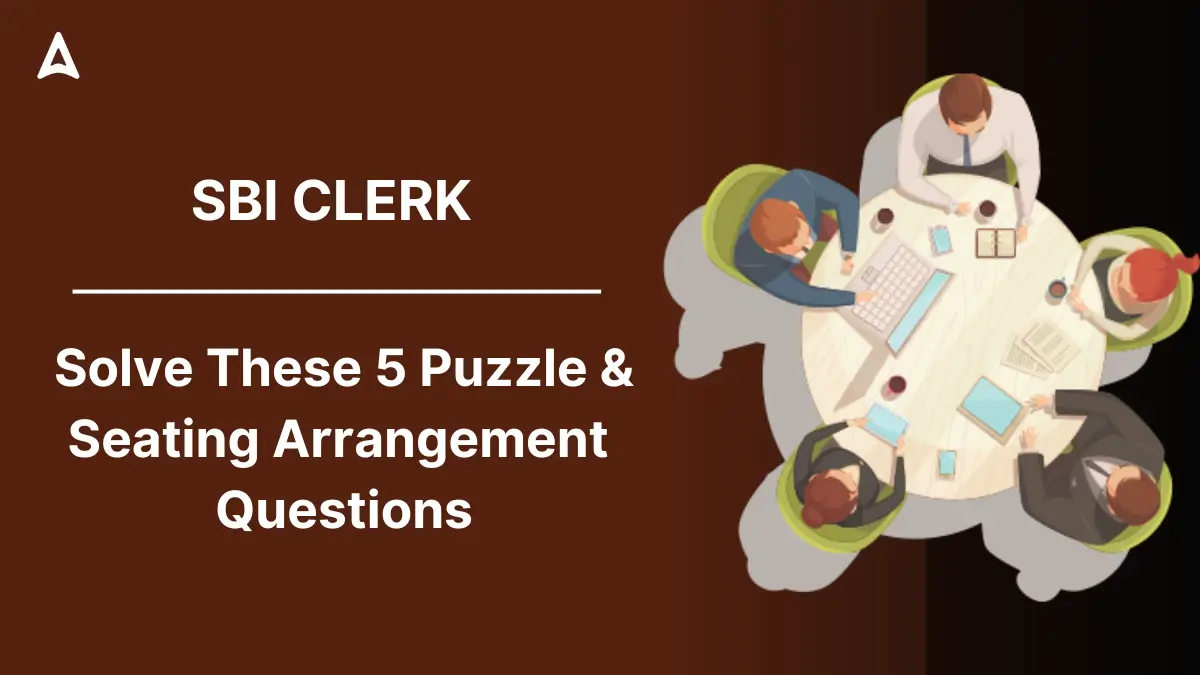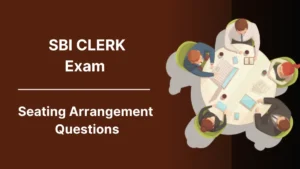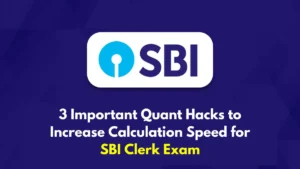Table of Contents
The Reasoning Ability section of the SBI Clerk Prelims Exam includes puzzles and seating arrangement questions, which can be tricky but are also high-scoring. Many candidates struggle with these questions because they require logical thinking and quick decision-making. But with regular practice, you can solve them easily and improve your accuracy. In this article, we will discuss the 5 most important puzzle and seating arrangement questions that you must solve before your exam to boost your reasoning ability score. Let’s take a look at them one by one.
Solve These 5 Puzzle and Seating Arrangement Questions Before SBI Clerk
Now we will discuss five important types of puzzle and seating arrangement questions that often appear in the SBI Clerk 2025 exam. Understanding these question types will help you improve your logical reasoning skills and boost your exam performance. We will also provide five practice questions so that you can test your understanding and enhance your accuracy.
Circular Seating Arrangement
In these types of questions, people are seated around a circular table, either facing the center (inward) or away from it (outward). Additional information, such as professions, colors, or favorite subjects, may also be provided.
Directions (1-5): Study the following information carefully and answer the questions given below:
Eight Cricketers are sitting around a circular table facing the centre. Each of them is belongs different country. F is sitting second to the left of A. The one who is belongs Australia is an immediate neighbour of A. There are only three people sitting between the one who is belongs to Australia and E. Only one person sits between the one who is belongs to England and E. The one who is belongs to South Africa is to the immediate right of the one who is belongs to England. B is second to the right of A. H belongs to Australia. G and C are immediate neighbours of each other. Neither G nor C belongs to England. The one who is belongs to Pakistan is immediate left of F. The one who is belongs to West Indies is second to the right of the one who is belongs to South Africa. The one who is belongs to India is an immediate neighbour of the one who is belongs to England. G is second to the right of the one who is belongs to Bangladesh. D sits third to the right of the one who belongs to Sri Lanka.
Q1. Who among the following sits second to the left of the one who belongs to West Indies?
(a) B
(b) A
(c) F
(d) D
(e) C
Q2. Who among the following belongs to Pakistan?
(a) D
(b) A
(c) G
(d) E
(e) F
Q3. Which of the following statement is true about A?
(a) F sits third right of A
(b) A belongs to South Africa
(c) Only two persons sit between A and F
(d) A belongs to India
(e) A sits immediate left of G
Q4. What is the position of C with respect to H?
(a) Immediate left
(b) Second to the right
(c) Third to the left
(d) Fourth to the right
(e) None of these
Q5. Who among the following facing the one who belongs to Bangladesh?
(a) B
(b) H
(c) G
(d) F
(e) C
Linear Seating Arrangement
This involves a group of people seated in a straight row, facing either North, South, or a mix of both. The challenge is to determine each person’s exact position based on the given clues.
Directions (6-10): Study the following information carefully and answer the question given below.
Eight persons are sitting in a straight line and all are facing north direction. Each of them prepares for different competitive exam. S prepares for Bank and sits third to the right of Q. R sits immediate left of V who prepares for SSC. The one who prepares for AFCAT sits second to the left of Q. The one who prepares for UPSC sits third to the left of V. W prepares for NDA and he is an immediate neighbour of U who does not prepare for AFCAT. V is not an immediate neighbour of S. Persons who prepare for CDS and UPSC sit together. T sits third to the left of the one who prepares for UGC NET. W is not an immediate neighbor of S. P does not prepare for CTET.
Q6. Who among the following person prepare for CTET exam?
(a) T
(b) R
(c) W
(d) U
(e) None of these
Q7. Who among the following person sits third to the right V?
(a) The one who prepares for AFCAT
(b) The one who prepares for CTET
(c) S
(d) P
(e) None of these
Q8. What is the position of Q with respect to T?
(a) Third to the right
(b) Immediate Left
(c) Second to the right
(d) Immediate Right
(e) None of these
Q9. Which of the following statement is not true about U?
(a) U prepares for CTET
(b) U sits immediate right of S
(c) U does not prepare for UPSC
(d) Only two persons sit between U and the one who prepares for SSC
(e) Both (b) and (d)
Q10. Who among the following sits immediate right of the one who prepares for UGC NET?
(a) V
(b) U
(c) W
(d) P
(e) None of these
Square Table Based Arrangement
Directions (11-15): Study the following information carefully and answer the questions given below:
Eight persons of different ages sit around a square table. Four of them sit at corners and face outside and the remaining sit at middle of the sides of the square table and face inside. Persons ages are in Arithmetic Progression and sum of their ages is 96 years. B sits 2nd to the right of A who is oldest person. Two persons sit between A and Q who is 5 years old. Person whose age is 7 years is just older than Q who sits next to B who is just older than P and just younger than Z. D and Z sits opposite to each other. C is older than Z and younger than X who sits next to Q. C is an immediate neighbor of P and Z. Only one person is younger than D who sits at corner.
Q11. Who among the following is 3rd youngest person?
(a) P
(b) Q
(c) Z
(d) X
(e) None of these
Q12. What is the sum of the ages of C and B?
(a) 18
(b) 24
(c) 26
(d) 27
(e) None of these
Q13. How many persons are older than Z?
(a) Three
(b) Four
(c) Five
(d) Six
(e) None of these
Q14. What is the position of 2nd youngest person with respect to 2nd oldest person?
(a) Immediate left
(b) Immediate right
(c) 2nd to the left
(d) 2nd to the right
(e) None of these
Q15. Four of the following five are alike in certain way and hence form a group, find the one which does not belong to that group?
(a) P
(b) A
(c) Q
(d) Z
(e) D
Floor-Based Puzzle
In these puzzles, people live on different floors of a multi-story building. Each person may have additional attributes, such as a profession, favorite color, or vehicle type. Your goal is to arrange them correctly based on the given conditions.
Directions (16-20): Study the given information carefully and answer the related questions:
Eight persons P, O, L, I, U, Y, H and R live on different floor of a four-building where ground floor is numbered as 1, the floor just above it is numbered as 2 and so on till the topmost floor is numbered as 4. Each floor has two flats i.e., flat 1 and flat 2 (from west to east in the same order as given). Two floors gap between U and O and they live in different numbered flat. L lives on the same floor of O and to the north of R. One floor gap between R and P. Y lives north-west of H.
Q16. Who among the following lives just below I’s flat?
(a) P
(b) U
(c) No one
(d) H
(e) None of these
Q17. Four among the following five are same in a certain way and forms a group. Who among the following does not belong to the group?
(a) Y
(b) R
(c) P
(d) U
(e) I
Q18. Which of the following statement is correct?
(a) P lives in flat 2
(b) One floor gap between H and O
(c) L and Y live in same numbered flat
(d) I lives on 3rd floor
(e) All are correct
Q19. Who among the following lives just north-east of P?
(a) H
(b) I
(c) L
(d) O
(e) None of these
Q20. What is the direction of Y with respect to U?
(a) North-east
(b) South
(c) North-west
(d) South-west
(e) None of these
Box-Based Puzzle
This puzzle presents a stack of boxes, each with unique characteristics like different colors, weights, or labels. Your task is to arrange them in the correct order based on the given conditions.
Directions (21-25): Study the following information carefully and answer the questions given below.
Nine boxes are kept in nine different shelves of a cupboard such that the bottommost shelf is numbered as 1, just above the shelf 1 is numbered as 2 and so on till the topmost shelf is numbered as 9. Number of boxes kept above box N is 2 more than the number of boxes kept below box N. Two boxes are kept between box N and box M. Box R is placed two places above box M. Box C is kept on an odd numbered shelf below box N. Sum of the shelf number of box Z and box P is equal to the shelf number of box L. Difference between the shelf number of box P and box C is equal to box K. Box S is placed below the 5th shelf. Box Z and box P are placed at even numbered position.
Q21. Which of the following box is kept at the 3rd shelf?
(a) Box C
(b) Box K
(c) Box S
(d) Box M
(e) None of these
Q22. How many boxes are kept between box Z and box L?
(a) Four
(b) Three
(c) Five
(d) Six
(e) None of these
Q23. Four of the following five are alike in a certain way and thus forms a group, which of the following doesn’t belong to that group?
(a) Box Z
(b) Box N
(c) Box P
(d) Box K
(e) Box L
Q24. What will be the sum of the shelf number of box R and Box S?
(a) 11
(b) 10
(c) 15
(d) 13
(e) 12
Q25. Which of the following box is kept just below box M?
(a) Box P
(b) Box S
(c) Box C
(d) Box Z
(e) None of these




 SBI PO Study Material 2025, Download Fre...
SBI PO Study Material 2025, Download Fre...
 Seating Arrangement Questions for SBI Cl...
Seating Arrangement Questions for SBI Cl...
 3 Important Quant Hacks to Increase Calc...
3 Important Quant Hacks to Increase Calc...


